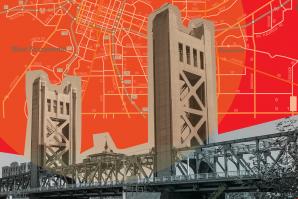Sacramento’s streetcar project gained steam Feb. 2 when supporters received promising news about federal funding, but opponents still question the streetcar’s potential benefits to downtown’s economic development.
The streetcar system, which supporters hope could be operational as soon as 2018, would run on a 3.3-mile loop through downtown and West Sacramento. Consultant group Strategic Economics projects an economic benefit of millions in retail spending in Sacramento and up to $1.9 billion in property value growth, all over a 20-year period. The Federal Transit Administration said it will help pay for the $150 million project, but first, supporters have to raise matching funds.
In addition to a vote from property owners agreeing to pay $30 million toward the project, the initiative needs $10 million from the state and $3 million from Sacramento County, says Kirk Trost, chief operating officer of the Sacramento Area Council of Governments. Trost isn’t worried about the property owner vote — he says many of them understand the potential return on investment.
“We’ve spent a lot of time going out and meeting with individual developers and developer teams over the last several months,” Trost says. “In every case, when we’ve sat down and gone through details of the economic benefit study and details of the project, not a single person has said, ‘No, I don’t get it; it doesn’t make sense to me.’”
Property developer David Taylor, who developed Sacramento City Hall, says streetcars have the potential to help solve downtown Sacramento’s parking problems. Tourists and locals headed to the city’s center could take a $1 streetcar ride instead of searching for a parking spot.
“That psychological barrier (of needing to find parking) really stifles economic activity,” Taylor says. “With the streetcar, you can go from West Sacramento to K Street for lunch.”
Mark Friedman, president of Fulcrum Property, first saw the value of the project after visiting Portland — which has its own streetcar system — a decade ago.
“I saw the impact of the (streetcar) line on surrounding development and property values,” Friedman says. “It was relatively easy for me to reach the conclusion that installing the system here increases the value of assets.”
Friedman and other supporters have lauded the success of streetcars in Portland, pointing to $3.5 billion in economic development, with 55 percent of new developments downtown setting up within a few blocks of the streetcar. Portland’s City Auditor’s Office, however, said in a December 2014 report that the two aren’t necessarily connected.
“The question is, if you add transit along a corridor where there’s already growth or activity, will there be more growth along that main street due to adding the transit?” said Drummond Kahn, Portland’s director of audit services.
The report concluded that the Portland Bureau of Transportation has not yet met the city’s goals for tracking performance measures. Kahn said the city will follow up with another audit in a year.
According to the report, streetcar ridership in Portland has increased since 2002, though levels have decreased slightly since 2009.
Craig Powell, president of watchdog group Eye on Sacramento, says Portland’s development success came from financial incentives the city gave to property owners, and Sacramento can’t afford that kind of investment.
Powell says interest rates would likely cause the $30 million tax quoted to property owners to climb closer to $75 million.
“We’re worried it could be a fad,” he says. “The fad might stay for five years, but with capital costs, we have 35 years to pay it off. If (the streetcar) starts losing a lot of money, we can’t cancel this. If the losses get too big, we’re stuck.”
Recommended For You

Streetcar Named Desire
Funding questions loom over downtown streetcar project
For nearly two decades, local city officials have envisioned a streetcar that would transport residents and visitors across downtown Sacramento.

Bridging the Divide
West Sacramento’s massive transportation shift is redefining its identity
Long regarded as the region’s industrial bastion relegated to the other side of the river, today’s West Sacramento is barreling out of the past.

Going Up
How one worker keeps operations at Tower Bridge golden
Bridge worker Scott Bennett has been tending to the iconic Sacramento structure for 12 years.

Green Grids
Transportation reforms throughout the region are changing the ways people live and travel in Yolo County
It’s been a year since Gov. Jerry Brown signed legislation that created the Active Transportation Program to boost non-motorized transportation across the state, where one in four Californians are obese and more than 3.9 million are diabetic. And as California emerges as a national leader in transportation reform, Yolo County is finding itself at the forefront of the movement.




Comments
So if federal money is available for something, we should build it? The premise is flawed. Streetcars, by virtue of requiring tracks, are an inferior choice to busses, which are capable of sharing streets with cars. Despite the near religious fervor with which anti car zealots promote anything on rail, in most cases (BART and other fast regional transit are exceptions) rail projects do not stand up to rational cost-benefit analysis. Commission a few more busses, and you address any transit issues that streetcars may supposedly ameliorate, at far lower cost and to far better effect.
You are absolutely correct. Having lived in a couple of those cities cited, I know that those rails only work because of their HEAVY residential components. Sacramento does not have this yet and 10,000 more housing units in the CBD won't support it or the businesses in what remains of the Plaza. It is a fantasy to think that sports fans in any number at all will take light rail or drive in and Park where? (already over crowded midtown streets?) and then walk how many blocks to board a slow moving street car? Won't happen and we property owners will be stuck with an ever increasing bill as Powell is fearful of. This does not even consider the traffic nightmares during and after construction on the streets on which teh street car will be running. Those that are so gun hoe on it, should be made to live in the central city rather than their quiet, comfortable upscale suburban neighborhoods. Buses are the most flexible and cheapest way to go.